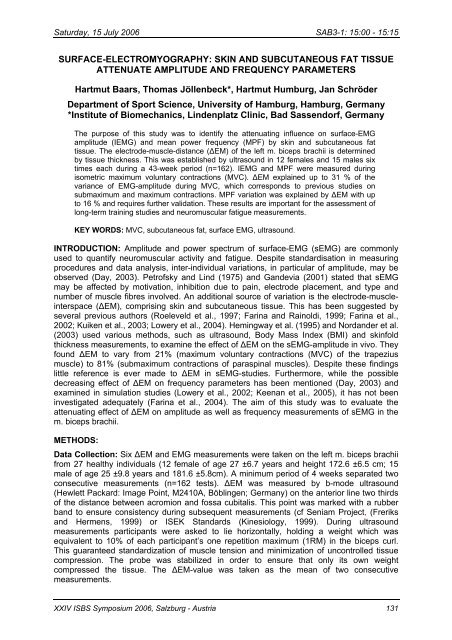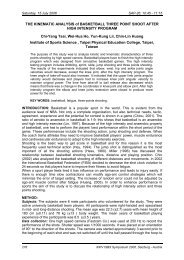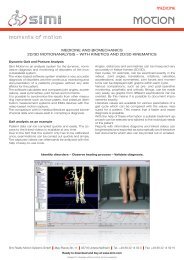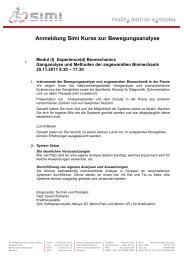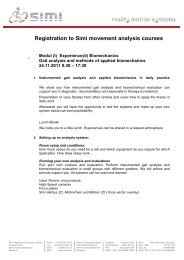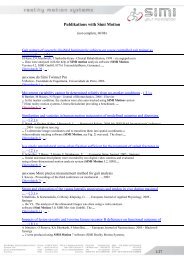SURFACE-ELECTROMYOGRAPHY: SKIN AND SUBCUTANEOUS ...
SURFACE-ELECTROMYOGRAPHY: SKIN AND SUBCUTANEOUS ...
SURFACE-ELECTROMYOGRAPHY: SKIN AND SUBCUTANEOUS ...
You also want an ePaper? Increase the reach of your titles
YUMPU automatically turns print PDFs into web optimized ePapers that Google loves.
Saturday, 15 July 2006 SAB3-1: 15:00 - 15:15<br />
<strong>SURFACE</strong>-<strong>ELECTROMYOGRAPHY</strong>: <strong>SKIN</strong> <strong>AND</strong> <strong>SUBCUTANEOUS</strong> FAT TISSUE<br />
ATTENUATE AMPLITUDE <strong>AND</strong> FREQUENCY PARAMETERS<br />
Hartmut Baars, Thomas Jöllenbeck*, Hartmut Humburg, Jan Schröder<br />
Department of Sport Science, University of Hamburg, Hamburg, Germany<br />
*Institute of Biomechanics, Lindenplatz Clinic, Bad Sassendorf, Germany<br />
The purpose of this study was to identify the attenuating influence on surface-EMG<br />
amplitude (IEMG) and mean power frequency (MPF) by skin and subcutaneous fat<br />
tissue. The electrode-muscle-distance (∆EM) of the left m. biceps brachii is determined<br />
by tissue thickness. This was established by ultrasound in 12 females and 15 males six<br />
times each during a 43-week period (n=162). IEMG and MPF were measured during<br />
isometric maximum voluntary contractions (MVC). ∆EM explained up to 31 % of the<br />
variance of EMG-amplitude during MVC, which corresponds to previous studies on<br />
submaximum and maximum contractions. MPF variation was explained by ∆EM with up<br />
to 16 % and requires further validation. These results are important for the assessment of<br />
long-term training studies and neuromuscular fatigue measurements.<br />
KEY WORDS: MVC, subcutaneous fat, surface EMG, ultrasound.<br />
INTRODUCTION: Amplitude and power spectrum of surface-EMG (sEMG) are commonly<br />
used to quantify neuromuscular activity and fatigue. Despite standardisation in measuring<br />
procedures and data analysis, inter-individual variations, in particular of amplitude, may be<br />
observed (Day, 2003). Petrofsky and Lind (1975) and Gandevia (2001) stated that sEMG<br />
may be affected by motivation, inhibition due to pain, electrode placement, and type and<br />
number of muscle fibres involved. An additional source of variation is the electrode-muscleinterspace<br />
(∆EM), comprising skin and subcutaneous tissue. This has been suggested by<br />
several previous authors (Roeleveld et al., 1997; Farina and Rainoldi, 1999; Farina et al.,<br />
2002; Kuiken et al., 2003; Lowery et al., 2004). Hemingway et al. (1995) and Nordander et al.<br />
(2003) used various methods, such as ultrasound, Body Mass Index (BMI) and skinfold<br />
thickness measurements, to examine the effect of ∆EM on the sEMG-amplitude in vivo. They<br />
found ∆EM to vary from 21% (maximum voluntary contractions (MVC) of the trapezius<br />
muscle) to 81% (submaximum contractions of paraspinal muscles). Despite these findings<br />
little reference is ever made to ∆EM in sEMG-studies. Furthermore, while the possible<br />
decreasing effect of ∆EM on frequency parameters has been mentioned (Day, 2003) and<br />
examined in simulation studies (Lowery et al., 2002; Keenan et al., 2005), it has not been<br />
investigated adequately (Farina et al., 2004). The aim of this study was to evaluate the<br />
attenuating effect of ∆EM on amplitude as well as frequency measurements of sEMG in the<br />
m. biceps brachii.<br />
METHODS:<br />
Data Collection: Six ∆EM and EMG measurements were taken on the left m. biceps brachii<br />
from 27 healthy individuals (12 female of age 27 ±6.7 years and height 172.6 ±6.5 cm; 15<br />
male of age 25 ±9.8 years and 181.6 ±5.8cm). A minimum period of 4 weeks separated two<br />
consecutive measurements (n=162 tests). ∆EM was measured by b-mode ultrasound<br />
(Hewlett Packard: Image Point, M2410A, Böblingen; Germany) on the anterior line two thirds<br />
of the distance between acromion and fossa cubitalis. This point was marked with a rubber<br />
band to ensure consistency during subsequent measurements (cf Seniam Project, (Freriks<br />
and Hermens, 1999) or ISEK Standards (Kinesiology, 1999). During ultrasound<br />
measurements participants were asked to lie horizontally, holding a weight which was<br />
equivalent to 10% of each participant’s one repetition maximum (1RM) in the biceps curl.<br />
This guaranteed standardization of muscle tension and minimization of uncontrolled tissue<br />
compression. The probe was stabilized in order to ensure that only its own weight<br />
compressed the tissue. The ∆EM-value was taken as the mean of two consecutive<br />
measurements.<br />
XXIV ISBS Symposium 2006, Salzburg - Austria 131
Saturday, 15 July 2006 SAB3-1: 15:00 - 15:15<br />
Bipolar surface-EMG recordings were taken at the same location as ultrasound<br />
measurements, using Ag/AgCl electrodes with a centre-to-centre distance of 2.1cm. An A/Dconverter<br />
with a sampling rate of 1000Hz amplified the signals (x1000), which were then<br />
filtered with a lowpass filter of 500Hz and stored on a personal computer. EMG-signals were<br />
recorded during quasi-isometric MVCs on a biceps curler with the elbow flexed at 70° against<br />
a tension spring. Data obtained using an electronic goniometer (Biovision, Wehrheim,<br />
Germany) were stored on a personal computer for subsequent offline determination of<br />
marginal elbow angle changes. Strength was exerted gradually up to the maximum within 3<br />
seconds. There was no cheering on or visual biofeedback during contractions.<br />
Data Analysis: EMG raw data were full-wave-rectified and filtered (Moving Average). The<br />
integrated EMG (IEMG) [µV*s] was calculated using Simi Motion (Unterschleißheim,<br />
Germany) for the interval of one second following the point when maximum strength value<br />
was reached. The mean power frequency (MPF) [Hz] was calculated from the original data<br />
using a Fast-Fourier-Transformation (Hamming) with Statistica 5.0, being computed for the<br />
same interval as the IEMG. Differences between values were examined with t-tests;<br />
correlations between ∆EM, IEMG and MPF were established.<br />
RESULTS: Female ∆EM (0.31 ± 0.10 cm) was significantly stronger (t 0.01, 160 -3.351; p < 0.01)<br />
than male ∆EM (0.24 ± 0.14 cm). Male IEMG was 0,599 ± 0,331 µV, therefore being<br />
significantly higher (t 0.001 160 5.614; p < 0.001) compared with the female IEMG (0.355 ± 0.177<br />
µV). There was a negative correlation between ∆EM and IEMG which was significant (r = -<br />
0.559; p < 0.001) for all individuals combined, as well as for men (r = -0.545; p < 0.001) and<br />
women (-0.430; p < 0.001) separately. Results for correlations are graphically shown in figure<br />
1.<br />
MPF values (male: 79.1 ± 11.6 Hz; female: 77.4 ± 11.7 Hz) showed no inter-sex differences,<br />
but there was a significant negative correlation between MPF and ∆EM (all: r = -0.362; p <<br />
0.001; men: r = -0.412; p < 0.001, women: r = -0.275; p < 0.05).<br />
Figure 1: Left: ∆EM and surface-EMG amplitude (as integrated EMG) are negatively correlated in<br />
males and females. Right: ∆EM and mean power frequency (MPF) in males and females are also<br />
negatively correlated. Slope is smaller than for amplitude function. Both figures: n=162.<br />
DISCUSSION: The values of ∆EM and IEMG as well as MPF recorded as part of this study<br />
correspond well with those of previous investigations. As hypothesised, sEMG amplitude<br />
decreased with increasing ∆EM during maximum contraction. IEMG variance was explained<br />
by ∆EM (r 2 = 25-31%). There was also an inverse relationship between MPF and ∆EM (up to<br />
r 2 = 15%), the slope of which was smaller than in the IEMG – ∆EM function.<br />
The b-mode ultrasound method provided an exact determination of tissue thickness at the<br />
point of EMG measurement (Ishida et al., 1992). In accordance with Hemingway et al.<br />
(1995), BMI was not used as a measurement of ∆EM as it does not reflect the ∆EM of the<br />
specific recording site but of the whole body. Nordander et al. (2003) reported that<br />
correlations between EMG amplitude and tissue thickness are smaller when determined by<br />
ultrasound as opposed to skinfold measurements. However, calliper measurements can only<br />
132 XXIV ISBS Symposium 2006, Salzburg - Austria
Saturday, 15 July 2006 SAB3-1: 15:00 - 15:15<br />
give an estimation of ∆EM. Combined with the fact that measurements of skinfold thickness<br />
directly over the recording site were not successful in Nordander et al.’s study, it cannot be<br />
necessarily concluded that the method with the highest r 2 -values is the most precise one.<br />
Previous studies using both models and in vivo investigations had postulated that sEMG<br />
amplitude is attenuated by up to 62 % by local tissue between the electrodes and the muscle<br />
(Keenan et al., 2005). The present study was able to confirm these findings. A possible<br />
explanation may be signal weakening by subcutaneous fat tissue. Fat tissues may distribute<br />
the potential more widely (Farina and Rainoldi, 1999), therefore producing more cross-talk,<br />
which results in an underestimation of the IEMG (De la Barrera and Milner, 1994; Kuiken et<br />
al., 2003). Additionally, action potentials of motor units located more distantly from the<br />
electrodes may not be recorded at all (Barkhaus and Nandedkar, 1994).<br />
As a result, amplitude variation in the current study is explained to a lesser degree by ∆EM<br />
than in studies where submaximal contractions were used, and which found an explanation<br />
of sEMG amplitude variation of up to 81.2 % for paraspinal muscles (Hemingway et al.,<br />
1995). These deviations may be due to differences in the muscles investigated, as well as<br />
contraction type, quantification and amount of subcutaneous fat tissue and calculation of the<br />
sEMG-amplitude as root mean square (RMS). On the other hand, this study’s correlations<br />
between IEMG and ultrasound match Nordander’s results in the trapezius muscle ranging<br />
from r 2 = 21 % in MVCs to r 2 = 33 % for submaximal contractions (Nordander et al., 2003).<br />
The difference in r 2 between maximal and submaximal contractions may be due to the fact<br />
that the individuals being tested were not professional sports people. It is possible that pain<br />
inhibition or even lack of motivation influenced amplitude variance to a certain degree. As<br />
proposed by Hemingway et al. (1995), there may be a relationship between subcutaneous fat<br />
tissue and factors such as overall fitness, which in itself might result in the ability to develop<br />
higher activation levels.<br />
The negative correlation of MPF with ∆EM was much smaller than that of IEMG with ∆EM.<br />
Although common sense suggests otherwise, ∆EM appears to have a much weaker<br />
influence on frequency parameters than on amplitude. Small amounts of higher frequencies<br />
are often reported in calculations of the power spectrum. This has often led to the conclusion<br />
that subcutaneous fat tissue has a lowpass filter-like effect on higher frequencies due to the<br />
shape of the action potential waves (Farina et al., 2002; Day, 2003; Farina et al., 2004;<br />
Lowery et al., 2004). Decreases of higher frequencies, especially in simulation studies, may<br />
have resulted from the misleading assumption that action potentials (AP) should be<br />
examined as sinusoidal excitations of stationary signals, (e.g., Lowery et al., 2004). Single<br />
motor units are known to be excited by short AP spikes of up to 1 kHz with short amplitudes<br />
(Jöllenbeck, 2004). This is independent of muscle fibre type. As a result of these signal<br />
characteristics, the frequently quoted decreasing effect of ∆EM on MPF is unlikely to be the<br />
main source of the observation in the power spectrum described above. This means that<br />
interpretations of the mechanical effectiveness of frequency spectra in fatigue measurements<br />
may have been incorrect so far. Type IIb muscle fibres can develop a force five times larger<br />
than type I muscle fibres, which should be visible in evaluations of the power spectrum. This<br />
requires further investigation, in particular using different and non-standard analyzing<br />
methods described elsewhere (Jöllenbeck, 2004).<br />
CONCLUSION: The results of the study presented here show that there is an inverse<br />
relationship between ∆EM and sEMG amplitude as well as between ∆EM and MPF, albeit to<br />
a lesser extent. This means that interindividual variation of sEMG amplitude can be<br />
explained by tissue thickness, which should be taken into account in future sEMG studies. In<br />
particular, training studies which include sEMG measurements should be aware of the effect<br />
of ∆EM; assessing this effect should be part of the studies.<br />
Additionally, it is recommended that separate future investigations are made regarding<br />
frequency attenuation and interpretation of the mechanical effectiveness of frequency<br />
spectra.<br />
XXIV ISBS Symposium 2006, Salzburg - Austria 133
Saturday, 15 July 2006 SAB3-1: 15:00 - 15:15<br />
REFERENCES:<br />
Barkhaus, P., and Nandedkar, S. (1994). Recording characteristics of the surface EMG electrodes.<br />
Muscle Nerve, 17, 1317-1323.<br />
Day, S. (2003). Important Factors in surface EMG measurement, 2003, from www.bortec.ca.<br />
De la Barrera, E., and Milner, T. (1994). The effects of skinfold thickness on the selectivity of surface<br />
EMG. Electroencephalogr Clin Neurophysiol, 93, 91-99.<br />
Farina, D., and Rainoldi, A. (1999). Compensation of the effect of sub-cutaneous tissue layers on<br />
surface EMG: a simulation study. Med Eng Phys, 21, 487-497.<br />
Farina, D., Cescon, C., and Merletti, R. (2002). Influence of anatomical, physical, and detectionsystem<br />
parameters on surface EMG. Biol Cybern, 86, 445-456.<br />
Farina, D., Merletti, R., and Enoka, R. (2004). The extraction of neural strategies from the surface<br />
EMG. J Appl Physiol, 96, 1486-1495.<br />
Freriks, B., and Hermens, H. J. (1999). European Recommendations for Surface ElectroMyoGraphy,<br />
results of the SENIAM project. In B. a. H. R. P. EU (Ed.), SENIAM - Surface-Electro-MyoGraphy for<br />
the Non-Invasive Assessment of Muscles Roessingh Research and Development b.v., (CD-Rom).<br />
Gandevia, S. C. (2001). Spinal and supraspinal factors in human muscle fatigue. Physiological<br />
Reviews, 81, 1725-1789.<br />
Hemingway, M., Biedermann, H., and Inglis, J. (1995). Electromyographic recordings of paraspinal<br />
muscles: variations related to subcutaneous tissue thickness. Biofeedback Self Regul, 20, 39-49.<br />
Ishida, Y., Carroll, J. F., Pollock, M. L., Graves, J. E., and Leggett, S. H. (1992). Reliability of b-mode<br />
ultrasound for the measurement of body fat and muscle thickness. American Journal of Human<br />
Biology, 4, 511-520.<br />
Jöllenbeck, T. (2004). Wege aus der Sackgasse?Neue methodologische Ansätze zur EMG-gestützten<br />
Bewegungsanalyse. In: Riehle, H. (Hrsg.): Biomechanik als Anwendungsforschung - Transfer<br />
zwischen Theorie und Praxis. Schriften der dvs, Czwalina, Hamburg, 132, 270-277.<br />
Keenan, K., Farina, D., Maluf, K., Merletti, R., and Enoka, R. (2005). Influence of amplitude<br />
cancellation on the simulated surface electromyogram. J Appl Physiol, 98, 120-131.<br />
Kinesiology, I. S. o. E. a. (1999). Standards for Reporting EMG Data, Journal of Electromyography<br />
and Kinesiology (Vol. 1, pp. III-IV): International Society of Electrophysiology and Kinesiology.<br />
Kuiken, T., Lowery, M., and Stoykov, N. (2003). The effect of subcutaneous fat on myoelectric signal<br />
amplitude and cross-talk. Prosthet Orthot Int, 27, 48-54.<br />
Lowery, M., Stoykov, N., Taflove, A., and Kuiken, T. (2002). A multiple-layer finite-element model of<br />
the surface EMG signal. IEEE Trans Biomed Eng, 49, 446-454.<br />
Lowery, M., Stoykov, N., Dewald, J., and Kuiken, T. (2004). Volume conduction in an anatomically<br />
based surface EMG model. IEEE Trans Biomed Eng, 51, 2138-2147.<br />
Nordander, C., Willner, J., Hansson, G., Larsson, B., Unge, J., Granquist, L., and Skerfving, S. (2003).<br />
Influence of the subcutaneous fat layer, as measured by ultrasound, skinfold calipers and BMI, on the<br />
EMG amplitude. Eur J Appl Physiol, 89, 514-519.<br />
Petrofsky, J. S., and Lind, A. R. (1975). The relationship of body fat content to deep muscle<br />
temperature and isometric exercise performance. Clinical Science and Molecular Medicine, 48, 405<br />
412.<br />
Roeleveld, K., Blok, J., Stegeman, D., and van, O. A. (1997). Volume conduction models for surface<br />
EMG; confrontation with measurements [Record Supplied By Publisher]. J Electromyogr Kinesiol, 7,<br />
221-232.<br />
134 XXIV ISBS Symposium 2006, Salzburg - Austria


